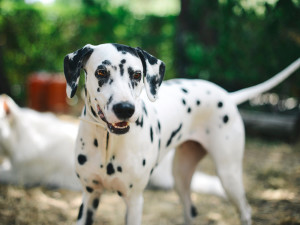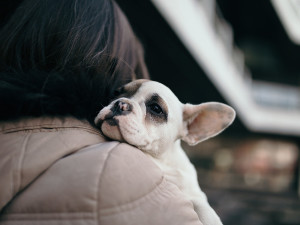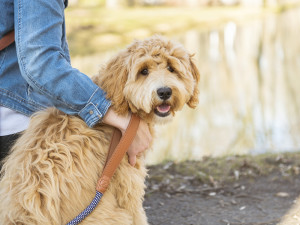Controversy Over Purebred Dog Breeding Documentary
Pedigree Dogs Exposed revealed how breed standards had contorted some breeds into increasingly unhealthy dogs.

share article

Your pet wants you to read our newsletter. (Then give them a treat.)
In August 2008, a powerful BBC documentary, Pedigree Dogs Exposed, rocked the dog world when it claimed to reveal the “greatest animal welfare scandal of our time.” Following its premiere, a review in a national newspaper said the show had “gone off like a bomb in quite a few British living rooms.” Four million British people watched, and the BBC received its biggest-ever viewer response to a single program. Middle England was outraged.
For decades, the details of dog breeding and showing had been closeted from the critical view of the outside world. While the comedy Best In Show famously took a peek and pointed a finger of fun at some breeders and exhibitors, Pedigree Dogs Exposed portrayed the pedigree dog world in a much more sinister light, and left the previously passive pet parent feeling furious and sad in equal measure. The eccentricity of the show world didn’t seem quite so amusing when people could see and hear that it apparently made dogs suffer.
It took filmmaker and dog lover Jemima Harrison two years to make Pedigree Dogs Exposed, but in just one hour, the scientific eye she cast over the dog-show world and the images she captured burned into people’s retinas as well as their minds. We saw a poor, beautiful Cavalier King Charles Spaniel screaming in pain because her skull was the wrong size for her brain, a Boxer having seizures, a German Shepherd hobbling around the show ring on strangely exaggerated limbs, a sweet show-winning Pug with a long line of Crufts winners in his pedigree and an equally long list of deformities. For many, it was an “Emperor’s New Clothes” moment as the program revealed how the show world had contorted some breeds into increasingly hideous and illogical shapes.
As Mark Evans, chief veterinary advisor at Britain’s biggest and oldest animal welfare charity, the Royal Society for the Prevention of Cruelty to Animals (RSPCA), said to the camera, “We are extremely concerned at the very high levels of disability, deformity and disease in pedigree dogs.” When he watched Crufts, he said, he saw a “parade of mutants.”
The Aftermath
The exposure left England’s Kennel Club reeling. It hadn’t come over well in the documentary, and Chairman Ronnie Irving had made some off-the-cuff remarks that would come back to haunt him.
For example, on the subject of inbreeding, he said, “I don’t want a bunch of scientists telling me they know more about it.” When pressed on the ethics of mother-to-son matings, he defended it and said it “depended on the individual mother and son.” (I’m sure I heard the sound of jaws dropping across the country at that moment.) Not long after the show aired, the Kennel Club rushed to ban such matings—it also launched a complete review of every pedigree dog breed in the UK and required breed clubs to adopt its Code of Ethics, which includes a clause that explicitly forbids the compulsory culling of healthy puppies—but the damage had already been done with that throwaway remark.
The Kennel Club says it was hit by a tsunami of hate after the program. At the Kennel Club Annual General Meeting during that period, Irving said they had “literally thousands of letters, emails and calls—some of them extremely aggressive and some actually threatening our staff in a frightening way.” Irving went on to say that “maybe worse were the many letters that we received from otherwise apparently sensible, intelligent people who had obviously swallowed the content of that program hook, line and sinker.” On their own forums, dog breeders complained of being spat at in the street.
The dog show world closed ranks, licked its wounds and waited for Pedigree Dogs Exposed to become yesterday’s news. But the program had opened Pandora’s box, and there was no going back.
The domino effect was staggering. After more than 40 years of televising it, the BBC dropped Crufts, the Kennel Club’s own dog show. Three powerful welfare charities—the RSPCA, Dogs Trust and PDSA—spectacularly pulled out of attending the show due to adverse supporter pressure, and others withdrew sponsorship. A marketing guru simply said that as a brand, Crufts had become toxic.
But was the program unfair to the Kennel Club? Could the club have done anything more to protect pedigree dogs from suffering? Was the public simply expecting far too much of it?
At this point, I have to confess that I used to work there. It was decades before this and in quite a minor role. It may sound like hindsight, but I did try my best to warn them that there might be a tidal wave approaching. I grew up at dog shows, and even then, it occurred to me that the concepts of pedigree dogs and kennel clubs were relatively recent in historical terms, and no one seemed to have a plan for what to do as the gene pools shrunk ever further.
Pedigree Dogs Inbreeding Studies
One of the studies referred to in the documentary was a groundbreaking Imperial College, London, investigation into inbreedingopens in a new tab. The researchers studied 10 breeds and found that these breeds had lost more than 90 percent of the genetic variation they had had 35 years ago. Decades of overuse of popular sires and linebreeding (breeding of dogs who share a common ancestor) had led to the sort of genetic erosion that made the giant panda look like a much safer bet for avoiding extinction than the Pug.
World-renowned geneticist Professor Steve Jones at the University College, London, was the voice of doom in the film. “If the dog breeders insist on going further down that road, I can say with confidence, really, that there is a universe of suffering waiting for many of these breeds—and many, if not most, of these breeds, will not survive. They will get so inbred that they will be unable to reproduce and their genes will come to a dead end.”
Earlier in its history, the Kennel Club seemed to have gotten off on the right foot. Their hip-scoring scheme was revolutionary and promised to help the growing problem of hip dysplasia in many breeds. But when the scheme was still in its infancy, the Kennel Club made a decision that, on the face of it, made no logical sense. In breeds with significant hip dysplasia problems, they decided not to make these tests a condition of using the registration system while, at the same time, opting to publish all the results—even the failures. Previously, they’d only publicized the successes; if anyone made a false claim about a dog that had failed, there’d be trouble.
World hip expert Dr. Malcolm Willis, senior lecturer in Animal Breeding and Genetics at Newcastle University, told me at the time that he thought it was madness. The number of breeders testing did indeed drop steeply—sadly, it’s human nature. Why would all but the most altruistic breeders risk a very public failure with a winning dog if testing weren’t mandatory?
Swedish Kennel Club Improvements
Thankfully, elsewhere, others were thinking more deeply and strategically. In no time at all, the Kennel Club was getting left behind. Case in point: the Swedish Kennel Club—a nonprofit association of regional clubs, founded in 1889—which I visited back in 1992. I recall noting at the time that it lacked the pomp of the UK version but rather, felt very forward-looking and modern.
For a start, it was refreshingly democratic—anyone who owned a Swedish Kennel Club registered dog was a member—and it was welcoming to mutts as well as pedigrees. Even back then, it was very customer-facing, employing lots of people to give advice over the phones. It offered a 24-hour helpline for lost dogs, one of the perks of having a registered dog.
But the real difference between the Swedes and the English was in their registration system. Long ago, the Swedish Kennel Club decided to make health testing mandatory. For example, back in 1992, 80 particularly afflicted breeds had to have both parents hip-tested if the breeder wanted to use the Kennel Club registration system; they’d already seen huge improvements in Newfoundland hips. They also decided to simplify the scoring system so it was clear to everyone how to interpret the results. They created three bands to encourage improvement: If your dog scored a grade 2, you couldn’t breed on. If your dog got a 0, you could choose a mate with either a 0 or a 1 score. But if your dog had a 1, they had to be mated to a dog with a 0.
It was the organization’s first step toward making its registration a mark of quality rather than a mere record of parentage. As more and more health tests became available, they were slotted into the existing system and again made conditional for breeders using the system. It seems so obvious now that this was in everyone’s best interests and provided a firm framework for improvement.
Lacking Progress
When the English Kennel Club is asked why it didn’t do the same thing, it says it was because it was afraid of losing breeders, of not taking them with them on the road for health reform. But the best English breeders already did all these tests, and more, without compulsion. Unfortunately, the public had no way of spotting the good guys as they rubbed shoulders in the same system with the inexperienced and the plain shoddy.
The Kennel Club also claimed it was afraid of breeders breaking away and forming alternative registries. Ironically, another registry saw and exploited a weakness: If the Kennel Club was providing expensive bits of paper that meant very little, why couldn’t it do the same thing, but charge less? By not being the best it could be, the Kennel Club allowed others an opening in which to compete for a slice of its registration revenue. The fear of taking the lead had lost it the race.
As inbreeding increasingly became an area of concern, the Swedes again were quick to break new ground. If any of you with purebred dogs have ever tried to calculate the level of inbreeding for your own dog, you’ll know how complex it is, and how time-consuming. The logical Swedes built the calculation into their pedigree database and made it freely accessible to all over the Internet. Using this information, breeders could see instantly how inbred any registered dog was and could create test matings and determine the level of inbreeding they might produce.
The Swedish Kennel Club also produced tables showing how inbred each breed was and charting trends, which allows the viewer to see if a breed is improving or not. It set bands for acceptable levels of inbreeding and started limiting the number of times a stud dog could be used in his lifetime.
While elsewhere around the globe, the cult of the top-winning show dog was dramatically shrinking the gene pool, the Swedes stopped some very inbred dogs from being brought into their country. (The big problem in Sweden now is dogs being smuggled into the country from Eastern Europe.) They made dog showing and breeding as meaningful as possible by adding temperament tests for some breeds before they could claim their titles, and required Border Collies to pass a herding test before being bred. They discussed how to reduce exaggerations caused by fashion and educated their judges without being provoked to do so by a national television exposé.
More Good Work
The Swedish Kennel Club worked closely with its government to pass a significant piece of consumer law, one that ensured that health and welfare were always at the top of every breeder’s agenda. In Sweden, if anything goes wrong with the health of a pup in the first three years, the breeder is financially responsible. With a system like that, who is going to have a litter from an untested pet Labrador just to fund a summer holiday? Who would want to be a puppy farmer if the breeder pays for a pup’s ill health?
Apart from having what I consider the best kennel club in the world, Sweden also seems to have cracked many other significant welfare problems that continue to plague other nations. By being strong, forward-thinking and logical, they’ve made dog breeding a respectable and professional thing to do, and made dog shows less like beauty pageants and more relevant to today’s society. In Sweden, they don’t have puppy mills. In Sweden, they don’t have pups for sale in pet shops. The few rescue shelters there are almost empty. No puppy is sold or labeled as “pet quality,” since the supposition is that they are all “pet quality”—family dogs or companion dogs first and anything else second.
Post-Pedigree Dogs Exposed, there have been several significant scientific reviews into dog breeding, and I’m hopeful that legislative changes will result that will give England a system as good as the Swedish model. This little documentary may ultimately have saved the dog from extinction.
A report recommending new standards of pedigree dog health in the UK to be released following an independent inquiry. Read more about it hereopens in a new tab.
Beverley Cuddy
Beverley Cuddy has been the editor and proprietor of UK-based Dogs Today magazine for 18 years. As a teenager, she showed Bearded Collies before becoming a pet owner and campaigning journalist.
Related articles
![Happy Labrador Retriever sitting on the floor]() opens in a new tab
opens in a new tabDid You Know 25% of Shelter Dogs Are Purebred?
If your heart is set on a purebred pup, start your search at breed-specific rescue organizations.
![designer dog breed Labradoodle on a leash looking at the camera]() opens in a new tab
opens in a new tabFrom Goldendoodles to Puggles — the Truth About “Designer Dogs”
Do your research. Know the facts.
![english Bulldog looking back at camera]() opens in a new tab
opens in a new tabGet Shorty: All You Need to Know About Bulldogs
So chill! So wrinkly! So allergic!
![A woman holding a French bulldog over her shoulder.]() opens in a new tab
opens in a new tabBulldogs and Other Flat-Faced Breeds Are Being Banned. Here’s Why
Breeds with those squished-in faces are charming — but their health issues are not.





